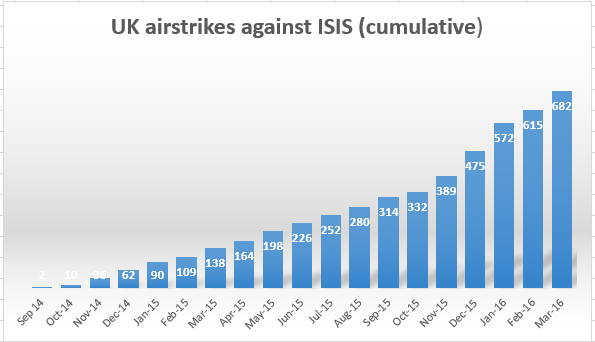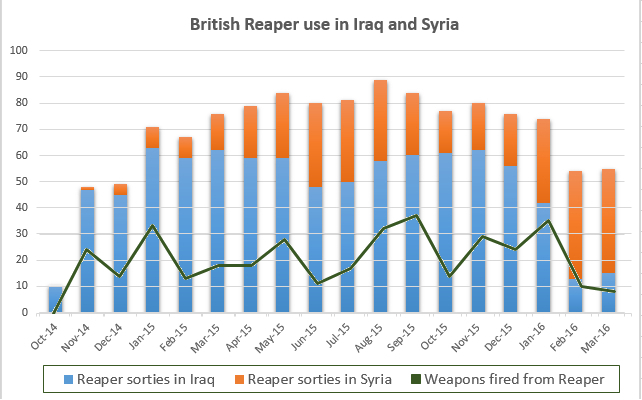Scepticism over casualty claims as new data suggests some UK drones may have moved
New data about UK military operations in Iraq and Syria has been released to Drone Wars UK and Vice News over the past few days following separate Freedom of Information (FoI) requests.
Vice News obtained details of the number of combatants killed or wounded in RAF strikes each month since Oct 2014. The data shows that just under 1,000 combatants had been killed with almost 100 wounded. While the MoD are extremely careful to say they cannot validate such casualty figures as they have no one on the ground, at the same time they continue to insist that no civilians have been killed in any of 740 British air strikes which have launched around 1,400 bombs and missiles.
The claims echo those of the US which argues that only around 40 civilians have “likely” been killed in a total of around 12,000 air strikes by the Coalition. Reports complied by Airwars indicate that a minimum of around 1,200 non-combatant civilians have died in these strikes.
Airwars founder Chris Wood told the Independent
“Even with the widespread use of relatively precise weapons by the West, air strikes are the most lethal weapon against civilians. It would be unprecedented in the history of warfare for it not to have killed civilians. It is a matter of public record there have been a huge number of civilian casualties and yet the Ministry of Defence continue to deny any caused by the UK.
UK air strikes increase
Figures released to Drone Wars for the first quarter of 2016 show an increase in UK air strikes. The number of strikes carried out by the UK in Iraq and Syria during first three months of 2016 were 30% higher than the previous quarter rising from 161 to 207. ‘Air strike’ however is something of a flexible term. The more reliable metric of ‘munitions fired’ shows a much greater increase of 80%, with 495 bombs and missiles fired in first quarter of 2016 compared with 274 in last quarter of 2015.

The data also shows that while the MoD deployed further aircraft in December 2015 following the decision by parliament to conduct strikes in Syria as well as in Iraq, the vast majority of British strikes continue to take place in Iraq – 86% (178) in Iraq and 14% (29) – in Syria since the beginning of January 2016.
Overall between Sept 2014 and the end of March 2016 the UK launched a total of 682 air strikes against ISIS launching 1,367 missiles and bombs according to MoD figures. See our statistics page for more details.
British drones in Iraq, Syria and… Libya?
In contrast with the general upward trend however, strikes from British Reaper drones against ISIS declined by around 50% between the two quarters. From October to December 2015 there were 37 drone strikes in Iraq and Syria while from Jan to March 2016 there were just 20. Although it may be thought that the drop in strikes from British drones may indicate an increase in their use for surveillance and intelligence gathering missions rather than for strikes, in fact the overall number of British Reaper sorties has declined by 22%.
SafeSubcribe/Instant Unsubscribe - One Email, Every Sunday Morning - So You Miss Nothing - That's It

The drop in Reaper operations in Iraq and Syria will add to speculation that some UK drones may have been moved to undertake missions elsewhere – perhaps over Libya alongside US drones.
Foreign Office Minister Tobias Ellwood told the Foreign Affairs committee that British aircraft were conducting surveillance flights over Libya but declined to name what aircraft were being used. Although MoD Ministers again told MPs that UK Reaper drones have only been deployed on intelligence, surveillance and reconnaissance sorties in Iraq and Syria, when asked directly how many “operations” UK Reaper drones have undertaken in Libyan airspace the MoD refused to comment. This however may be reading far too much into particular wording.
Support for military intervention against ISIS in Libya has ebbed and flowed over the past few months. In mid-April Defence Secretary Michael Fallon called ISIS in Libya “a direct threat to Britain”. However ten days later Foreign Secretary Phillip Hammond was arguing that there was no immediate threat from ISIS bases in Libya. For legal and diplomatic cover Western governments want Faiez Serraj, head of the UN backed unity government, to call for security assistance – something he has been reluctant to do since his arrival in Tripoli for fear of being seen within Libya as a western stooge.
A milestone for drones
 Meanwhile Reuters recentlyrevealed that in 2015, US drones launched more air strikes in Afghanistan than conventional aircraft for the first time.
Meanwhile Reuters recentlyrevealed that in 2015, US drones launched more air strikes in Afghanistan than conventional aircraft for the first time.
While the overall number of strikes in Afghanistan has declined from the height of the intervention in 2011, there have still been more than 1,200 US air strikes in Afghanistan since the ‘end of combat operations’ in December 2014.
In Afghanistan the percentage of strikes launched by drones has risen 10 fold over the past four years, from 5% in 2011 to 56% last year, with every indication that this was set to continue to rise in 2016 (see graph). In Iraq and Syria, according to figures released to Air Force Times, US drones have launched 7% of US weaponry – around 3,000 bombs and missiles – with 1 in 5 drone flights launching a strike.
While we are a long way from drones dominating air campaigns, the recent commitment of both the USand the UK to increase the number of armed drones in service, as well as their continued heavy investment in drone development for the future, will no doubt see a further rise in their use.




